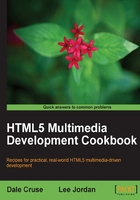
Conventions
In this book, you will find a number of styles of text that distinguish between different kinds of information. Here are some examples of these styles, and an explanation of their meaning.
Code words in text are shown as follows: "The new <header> is where we often store things like logos, company slogans, and other types of branding usually associated with mastheads."
A block of code is set as follows:
<div id="search-form"> <form role="search" method="get" id="searchform" action="http://devinsheaven.com/" > <div> <label for="s">Search for:</label> <input type="text" value="" name="s" id="s" /> <input type="submit" id="searchsubmit" value="Search" /> </div> </form> </div>
When we wish to draw your attention to a particular part of a code block, the relevant lines or items are set in bold:
<body>
<header>
<hgroup>
<h1>Roxane is my name.</h1>
<h2>Developing websites is my game.</h2>
</hgroup>
</header>
<nav role="navigation">
<ul>
<li><a href="#About">About</a></li>
<li><a href="#Work">Work</a></li>
</ul>
</nav>
</body>
New terms and important words are shown in bold. Words that you see on the screen, in menus or dialog boxes for example, appear in the text like this: "Choose Tools | Embed This Video from the Vimeo main menu."
Note
Warnings or important notes appear in a box like this.
Tip
Tips and tricks appear like this.